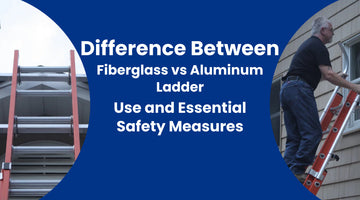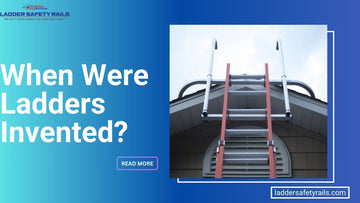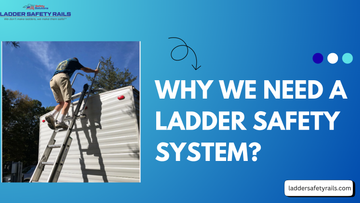Difference Between Fiberglass vs Aluminum Ladder: Use and Essential Safety Measures
Sep 11, 2024

Fiberglass and aluminum ladders are two of the most commonly available types of ladders. While personal preference plays a significant role in choosing a ladder, the decision involves more than just comfort. Several key factors determine which ladder is right for you.
If you're confused about the differences between fiberglass and aluminum ladders, we're here to help.
Continue reading to understand the key differences, as well as the advantages and disadvantages of each type.
Fiberglass Ladder:
Also known as, Fiberglass Extension Ladder, this type of ladder is well known for its strength and reliability. It is a top choice for both professional and residential users. It is typically heavier than aluminum ladders, which provides added stability and sturdiness, essential for tasks that require support for heavy loads.
They have a strong construction which makes them highly durable and resistant to bending or deformation, even under substantial pressure.
Another significant advantage is their resistance to rust and corrosion, which allows them to perform well in various weather conditions. Additionally, fiberglass ladders are non-conductive, offering superior safety when working near electrical sources. Despite their higher cost and bulkier design, the safety and durability of fiberglass ladders often justify the investment, particularly for demanding applications.
Aluminum Ladder:
Aluminum ladder (also, a lightweight ladder) is a popular choice as a result of its ease of handling, making it an ideal choice for a wide range of tasks. Their reduced weight allows for easy maneuverability and transportation, which is especially useful for projects that require frequent repositioning of the ladder.
Aluminum ladders are typically less expensive than fiberglass ladders, offering a cost-effective solution for many users. While they provide good strength and can support a considerable amount of weight, they are not as robust as fiberglass ladders and may bend or dent under extreme pressure.
However, one key disadvantage is that these ladders are more prone to rust and corrosion, particularly when exposed to moisture, necessitating regular maintenance.
Safety is another key consideration with aluminum ladders, as they are conductive and should not be used near electrical sources to prevent the risk of electrical shock.
Aluminum vs Fiberglass ladder: Key Differences

Here’s a comparison based on various aspects that will help you to understand which one is the top choice for you:
-
Height & Weight
Fiberglass Ladders: These ladders are generally heavier than aluminum ladders. This added weight contributes to their stability and sturdiness, making them suitable for heavy-duty tasks.
Aluminum Ladders: Aluminum ladders are much lighter, which enhances their portability and ease of handling. This makes them a good option for tasks that involve moving the ladder frequently.
-
Strength:
Fiberglass Ladders: Known for their strong construction, fiberglass ladders can support heavy loads and endure significant stress without bending or deforming. Their strength makes them ideal for demanding tasks and professional use.
Aluminum Ladders: While aluminum ladders are also strong, they are not as strong as fiberglass ladders. They can handle considerable weight but may bend or dent under extreme pressure, making them less suitable for very heavy-duty applications.
-
Durability
Fiberglass Ladders: These ladders are highly durable and resistant to rust and corrosion. They are designed to withstand harsh weather conditions and are less likely to suffer from wear and tear compared to aluminum ladders.
Aluminum Ladders: Aluminum ladders, while strong, are prone to rust and corrosion over time, especially when exposed to moisture. Regular maintenance is required to keep them in good condition and extend their lifespan.
-
Transportation
Fiberglass Ladders: Fiberglass ladders can be cumbersome to transport. This may be a disadvantage if the ladder needs to be moved frequently or carried over long distances.
Aluminum Ladders: The lighter weight of aluminum ladders makes them easier to transport and maneuver. This is particularly beneficial for tasks that require frequent repositioning or for users who need to carry the ladder to different locations.
-
Cost
Fiberglass Ladders: Typically more expensive than aluminum ladders, fiberglass ladders offer enhanced durability and safety features. The higher cost is often justified by their longevity and robust performance.
Aluminum Ladders: Generally, aluminum ladders are more budget-friendly. They provide a cost-effective solution for many users, particularly for lighter-duty tasks. However, the lower cost may come with trade-offs in durability and safety.
-
Safety
Fiberglass Ladders: One of the key advantages of fiberglass ladders is their non-conductive nature, making them safer for use near electrical sources. They offer added protection against electrical hazards and are a preferred choice for electrical work.
Aluminum Ladders: Aluminum ladders are conductive, which poses a risk when used near power lines or electrical sources. Special precautions must be taken to avoid electrical hazards, making them less suitable for tasks involving electricity.
Fiberglass vs Aluminum Ladder: Summary:

Why Choosing the right ladder is important?
Using a ladder suited to your specific needs minimizes the risk of accidents and injuries, especially when dealing with electrical hazards or heavy loads. It also enhances productivity by providing the right balance between weight, strength, and portability. Additionally, selecting a ladder with appropriate durability for the conditions you’ll be working in can save money in the long run and ensure compliance with safety standards.
So, Fiberglass or Aluminum Ladder? Well, in the end, your choice between fiberglass and aluminum ladders should depend on your specific needs, including the type of work you’ll be performing, budget considerations, and safety requirements.
Don’t take chances—invest in reliable safety tools today. Visit Ladder Safety Rails to learn more about ladder safety rules and ladder safety tips on our blogs page.
FAQs:
-
What is the difference between a fiberglass vs aluminum ladder?
Fiberglass ladders are heavier, non-conductive, and more durable, while aluminum ladders are lighter, more affordable, and conductive.
-
Can a fiberglass ladder be stored outside?
Yes, fiberglass ladders can be stored outside as they are resistant to rust and weather conditions.
-
Can you get electrocuted on a fiberglass ladder?
No, fiberglass ladders are non-conductive, making them safer for use near electricity.
-
Can you use an aluminum ladder near power lines?
No, aluminum ladders are conductive and should not be used near power lines due to the risk of electrical shock.
Read More Blogs Here:





